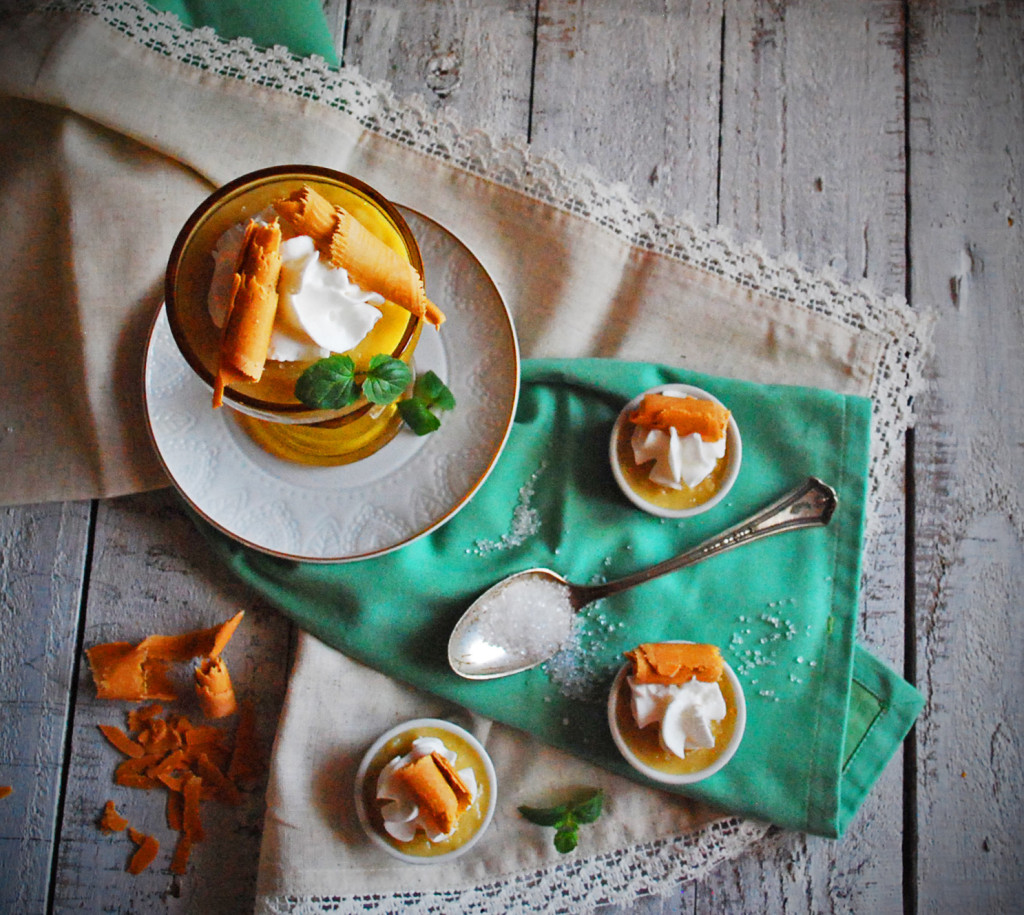
When I was a kid, one of my all-time favorite books was Jenny Wren, written by Dawn Watkins. The story is a gorgeously spun tale of a young orphaned girl who comes to live with her grandparents, the Logans. Throughout the story, Jenny is mistrustful, silent, and unforgiving, afraid to trust anyone after the hardships she has endured. Slowly but surely, the Logans win Jenny’s trust and teach her the true meaning of family, trust, and love. My Gram used to read to us from this book when we visited her Pennsylvania farm. We would cuddle up to her on the big, creaky swing under the birch tree and listen, entranced, as her voice painted the magical tale for us. Listening to the creek babble away beside us as we read, I could almost imagine that I was in the story with Jenny– running through the fields and discovering the magic of a country summer, right by her side.
When I went to college, I was thrilled to find that the author of Jenny Wren, as well as so many other of my favorite childhood books (like The Cranky Blue Crab, A King for Brass Cobweb, and Medallion) was a professor there. I was over the moon and couldn’t wait to sign up for her class. There was just one problem. Ms. Watkins taught only 1 class per semester– sometimes just 1 class per year, depending on the demands of her working and writing schedule. I also found out that her classes were open only to upperclassmen and graduate students. And I was only a sophomore. BLAH!!!!
The only way I could get into her class was for her to take a look at my application and personally allow me to stay. I knew it was a long shot, but I just had to give it a try. So, with much trepidation, I signed up for Poetry Writing with Professor Watkins, knowing nothing about poetry and just praying that, somehow, she would take pity on me and allow me to stay.
And, for whatever reason, she did let me stay. I was the youngest person in the class and way out of my league, but I have seldom enjoyed a class more, or learned more than what I eagerly soaked in that semester. When I asked her, years later, why she decided to allow me in, she said simply, “I don’t know. Something just told me you would be a good fit.”
Although I loved many classes, and although I loved many teachers . . . Ms. Watkins and her Poetry Writing Class remain one of my most treasured college memories. I truly cannot put into words how amazing an opportunity it was to be able to study writing under such a phenomenal author. Even neater was the fact that Ms. Watkins, like myself, had grown up in Pennsylvania and spent many cherished moments on her grandparents’ farm, as I had spent time similarly on my grandparents’ dairy farm. To this day, I am humbled and honored to be able to call her my friend. And I am so thankful that she was willing to let a lowly sophomore stay, even when I was out of my writing league 🙂
This classic dessert is an adaptation from an original recipe by Ms. Watkins’ Gram. In the days of instant everything, perhaps you’ve never tried real, old-fashioned pudding. Banish the thoughts of the tinny-tasting cafeteria stuff– this delight is rich and oddly comforting– for me, at least, it evokes memories of sitting down in a sunny farmhouse kitchen, with the breeze whispering through the open windows. Suddenly, I am a child again, with bare feet and skinned knees, and a whole summer of possibilities before me. If I close my eyes and imagine very hard, I can almost smell my Grandfather’s clothes– an intoxicating mixture of fresh air and hard work, and see the smile crinkling the corners of his face. And, deep down in my soul, I know that this . . . this is goodness.
What are we waiting for? Let’s do this!
Salted Caramel Cream Pudding Recipe
(adapted from Ms. Watkins’ original family recipe and used by permission)
Ingredients:
1/2 cup white sugar
1/2 cup brown sugar
1 tbsp. corn syrup
2 tbsp. water
1/4 cup flour
1 cup whole milk
1 egg, beaten
1 tbsp. butter
Pinch of salt
1 tsp. vanilla
Directions:
Heat sugars, corn syrup, and water in a small saucepan over medium low heat until the mixture boils. Stirring occasionally so mixture doesn’t burn, allow liquid to boil for about 10 minutes, until it becomes golden brown and smells like caramel– do not allow it to get so dark that it burns. A candy thermometer should read 240 degrees when it is finished. While mixture is caramelizing, prepare a small bowl with your flour, milk, beaten egg, butter, salt, and vanilla, so that it will be ready to pour in, all together, when you’re ready. When the caramel mixture reaches 240 degrees, remove from heat, and, while whisking, slowly add in the other ingredients. The mixture will foam a little bit, so be careful. When all the cold ingredients have been whisked in, turn the heat back to medium low and whisk until the mixture thickens, like pudding. Remove from heat, pour into prepared dishes, cover with plastic wrap, and refrigerate until ready to serve.
Now, in pictures! 🙂
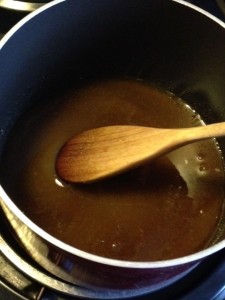
To begin with, this is not instant pudding. This is art. It takes time and patience to get it exactly right. So don’t rush it– enjoy the experience and savor every part.
Start by getting your sugar, corn syrup, and water going on medium low heat in a saucepan. If you have a candy thermometer, use it to help you know when the sugars have caramelized. If you don’t have a candy thermometer, don’t sweat it . . . you will be able to tell when it’s ready by the color and caramel smell. 🙂

Bring your mixture to a boil. This is where you want to start watching your thermometer. Caramel, at its root, is basically sugar that has been taken right up to the brink of burning and saved before it jumps off. Give this mixture the occasional stir, but don’t worry about it too much– the sugars are going to cook a little while until they get nice and toasty golden brown. That is the formation of the caramel– so just kind of watch the color, and when it starts to get golden brown, it’s almost there. If you are using a candy thermometer, watch for 240 degrees– that’s the magic number (reminds me of calling out exit numbers when I am the human GPS on trips . . . 240 is the one we want!).
While your sugar is being so good and toasting and caramelizing, for you, go ahead and get the next course ready. Mix everything else into a bowl and whisk the ingredients until they are well combined (it may take a little whisking to get the flour mixed in, completely). That way, your cold ingredients will be ready to pour into the caramel syrup when the sugar is finished roasting and toasting for you.
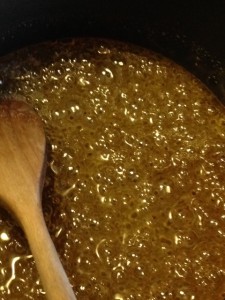
Mmmm. My thermometer says 240. This is what it should look like– nice and golden brown– like a senior citizen after a FL winter . . . and it should smell sweet and, well . . . like caramel. (If the senior citizens in your life smell like caramel, be suspicious and check their pockets for Werther’s Original candies, which they seem to smuggle in every pocket. And what’s wrong with that, I’d like to know? Yum).
Since we have hit that magical 240, go ahead and remove the pan from the heat. Carefully (because it spatters and foams a little bit) add the milk/flour mixture to the caramel, whisking as you go.
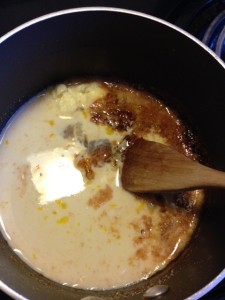
Once the cold ingredients have been added, and hopefully no one has been burned, move the pan back to the burner and whisk as the mixture heats up, again.
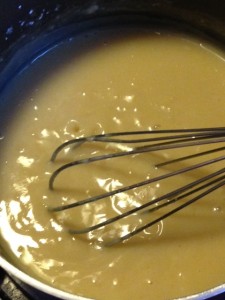
It doesn’t take long . . . in just a few minutes, your mixture will be a lot more like pudding– kind of the consistency of soft-set pudding or a thick gravy. And, presto . . . she’s done. Take this delightful stuff and pour it into dishes. Cover it with plastic wrap and wait for it to completely “set,” or get nice and thick and creamy for you.
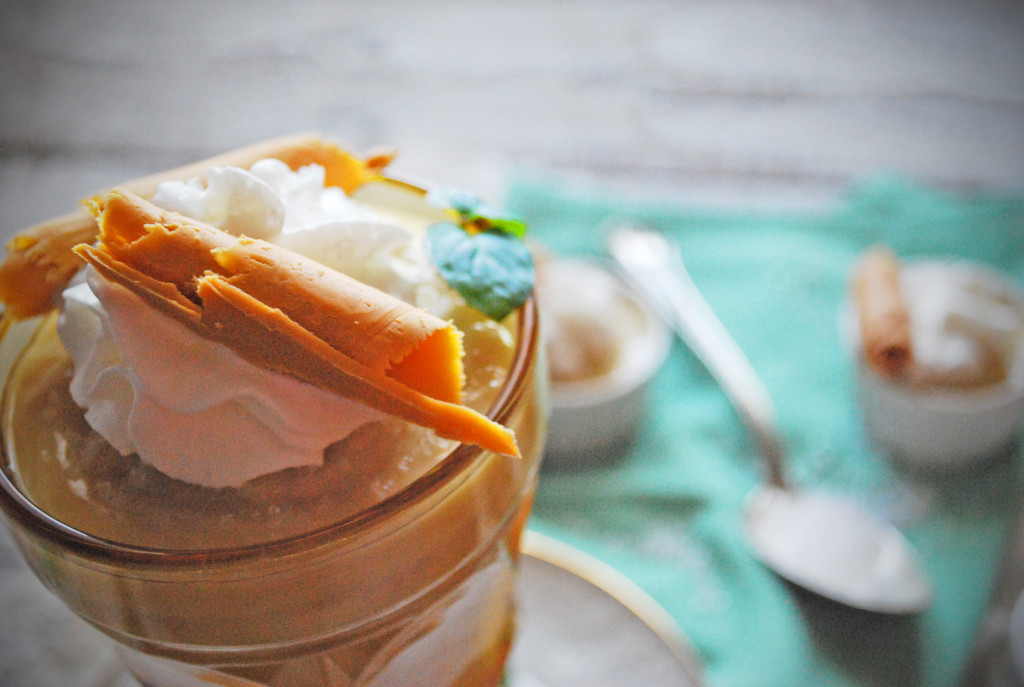
When the puddings are completely cool and set, now it gets fun. Now it’s time to garnish. I made some butterscotch curls (I’ll have to do a tutorial on how to do that, at some point– it’s easy and fun!) out of butterscotch chips, and they were the perfect complement to the caramel pudding.
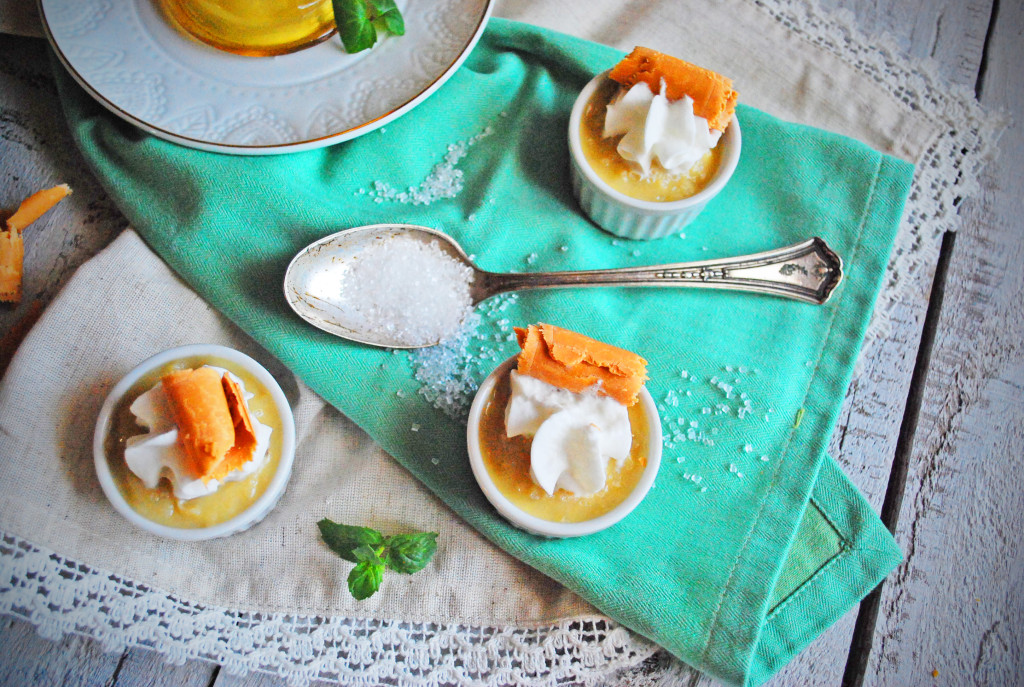
I made some large and some teeny, bite-sized puddings. I can just imagine how fun it would be to do a variety of flavors and put them before guests in little ramekins or shot glasses. How fun to have 4 little desserts on a plate . . . all for you!
I garnished with whipped cream and my butterscotch curls. Give them a little sprinkle of sea salt, too, for a really nice flavor contrast.
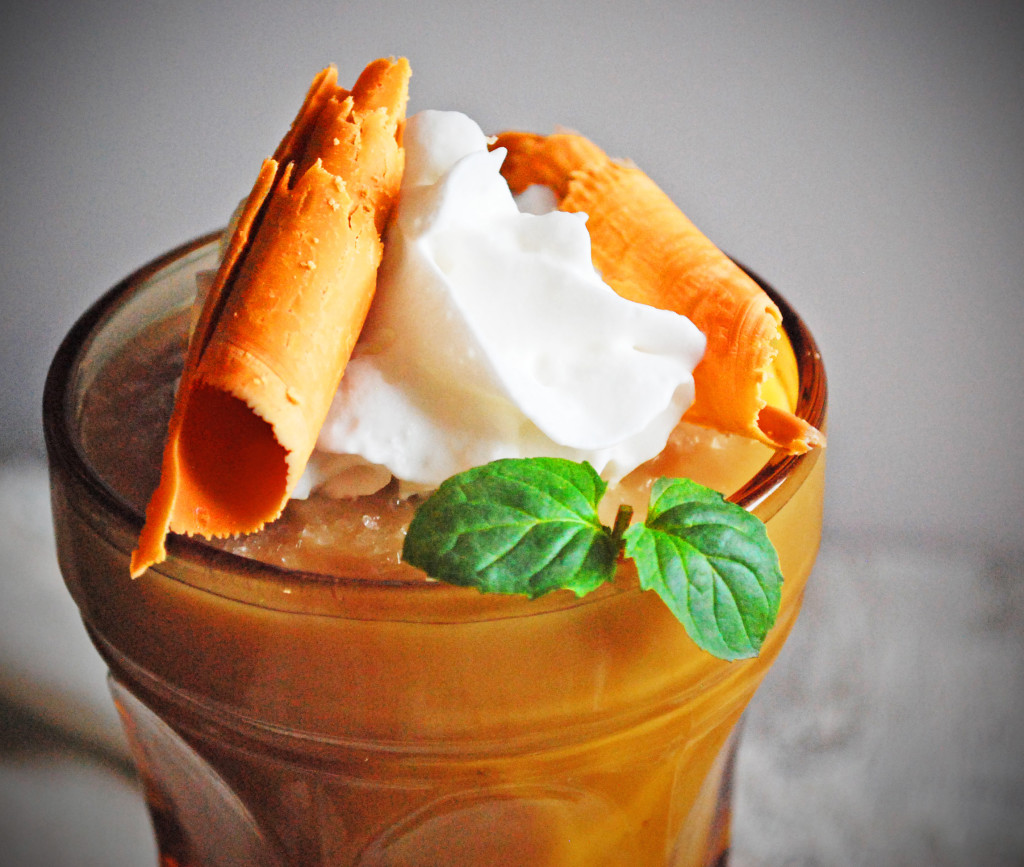
Oh my goodness. Would you look at that.
Sometimes the simplest things in life really are the best.
You did it. And I’m just so proud of you.

Disclosure: This post may contain affiliate links, which just means that we get a few pennies if you purchase through our link. I never recommend products that I don't personally use and love. Thanks!
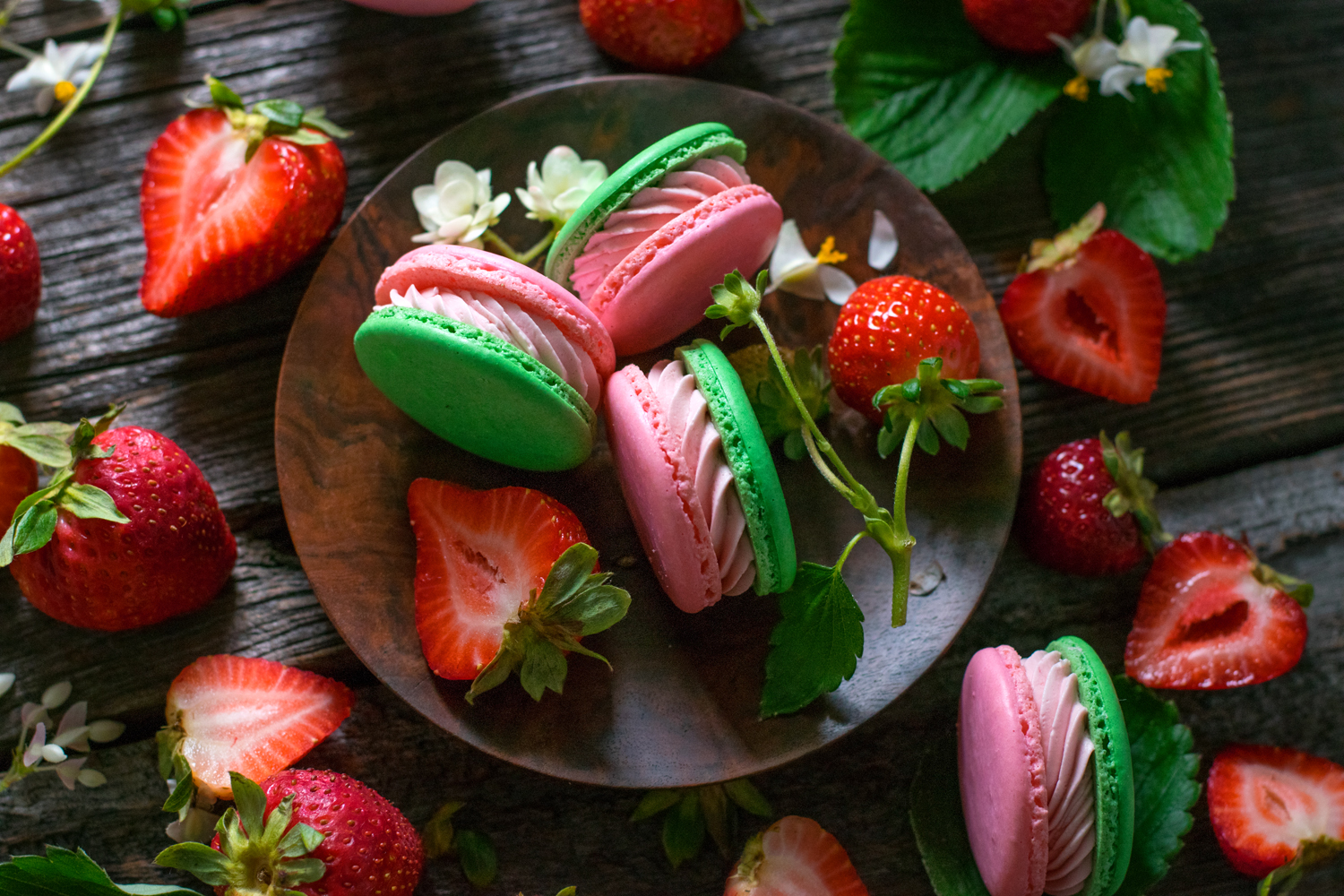
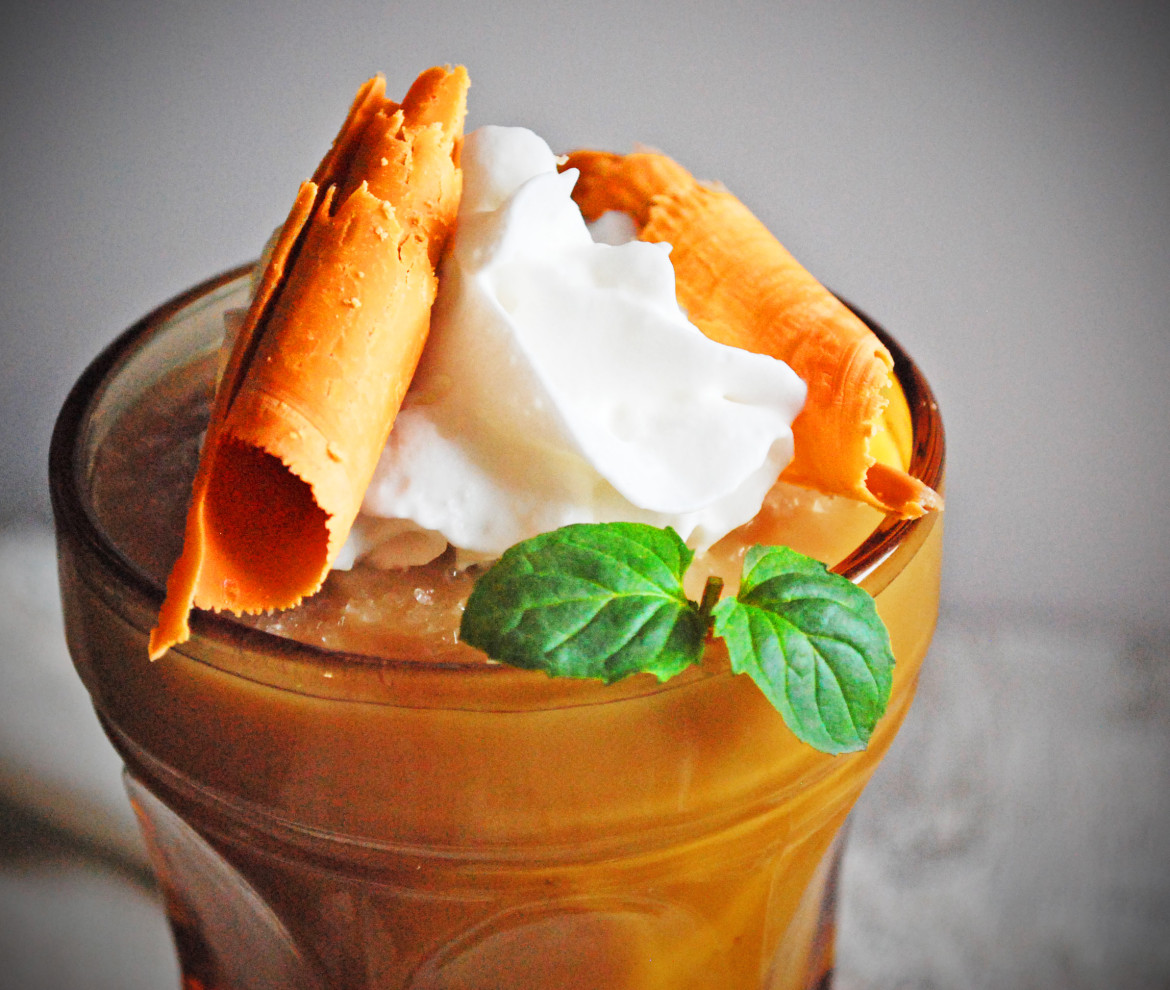
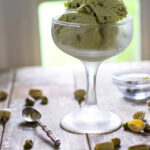
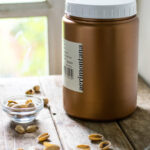

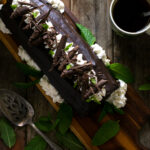
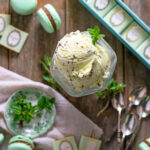
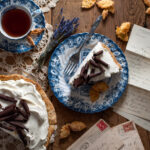
Pingback: Homemade Salted Caramels – Cookies for England